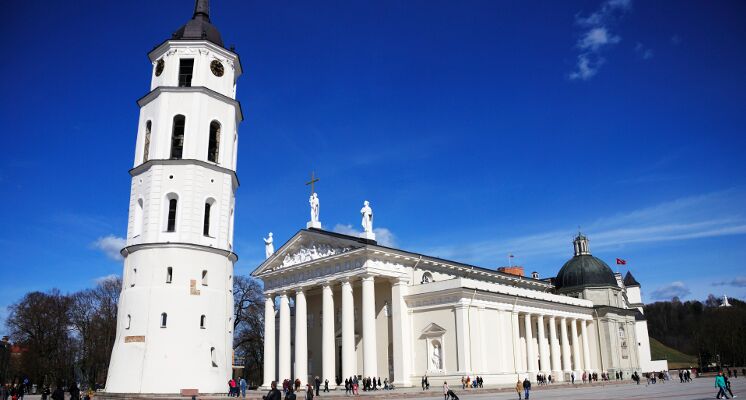The first Cathedral, built in the style of Gothic, stood in the place of contemporary cathedral, but covered smaller area. In year 1251, Mindaugas and his family were christened. In the same year (1251), Saint Father passed a bull, announcing Lithuania a kingdom – Lithuania was the only pagan kingdom in Europe. In year 1253 Mindaugas was crowned. After 10 years he and his family, because of political reasons, were murdered. After the dead of Mindaugas, the Cathedral was used for the pagan purposes (as supposed, for the cult of Thunder, the most important pagan god) till the christening of Lithuania (this happened in year 1387).
The Cathedral suffered many times from fires and wars and had six very important rebuilds. The last rebuild was begun in year 1783 by Laurynas Stuoka-Gucevičius and terminated in year 1801 by Mykolas Angelas Šulcas. After the last reconstruction, the Cathedral became neoclassical. Stuoka-Gucevičius tried to give symmetric look to cathedral (for the purposes of symmetry, vestry was added), but tried to save as much elements from earlier times as possible. So, gothic undergrounds (catacombs), baroque chapel of St. Casimir and Valavičių chapel were saved.
On the roof, we see (from left to right) sculptures of St. Stanislavas, St. Elena and St. Casimir. These sculptures, originally made by Karolis Jeltskis, in year 1950 were taken away and destroyed. The sculptures were rebuilt in 1997 by famous sculptor Stanislavas Kuzma.
On the timpani – scene of sacrifice of Noy (author – Thomas Riggi). Up to niches we can see five high relief figures – scenes from the life of apostils Petras and Povilas. In the niches – sculptures of Abraom, Moze and four evangelists, left – Lukas and Jonas, right – Morkus and Matas.
In the soviet times (1950) Cathedral was closed. It was thought to turn the building to the store, but finally decided to open picture gallery here. It was done in year 1956. Year 1988 Cathedral was given back to believers as a spiritual building.
About us
Contacts
All rights reserved | Vivid Vilnius Belongs to VšĮ "Ekskursijos Vilniuje" į.k. 304215124

